
The Ragas Live Festival 2017 is almost here! October 21 through October 22, for twenty-four hours straight, dozens of world-class musicians will perform ragas—from Indian classical pieces to modern interpretations—throughout the Rubin Museum. Each raga is composed for a specific time of day and allegedly has the power to alter the consciousness of a listener at the right time and place.
The raga performers that are participating in the festival come from a range of backgrounds and will bring different flavors of sound and emotion to visitors over the course of the overnight event. In advance of the festival, we spoke with a few performers to get a preview of the concerts and learn about some of the instruments visitors can expect to see and hear.
Samir Chatterjee, tabla
A pillar of the Indian classical community, Samir Chatterjee has performed with countless music legends, from Ravi Shankar to Ravi Coltrane. The virtuoso will be performing a 7 P.M. tabla duo with his son Dibyarka in what promises to be an explosive beginning to the evening set.
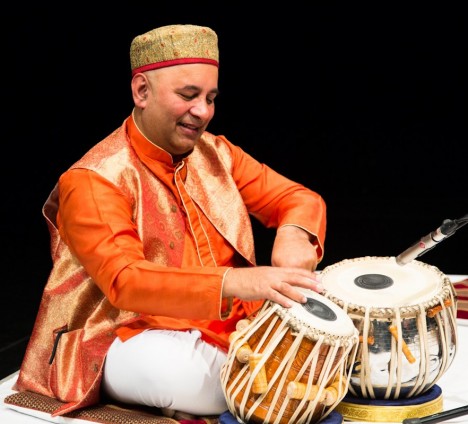
What’s time of day do you find most inspiring?
Dawn. The transition from darkness to light carries manifold significance in my life. I love that energy.
What can listeners expect from your performance?
They can expect a share of my emotional and spiritual evolution, as they manifest through my music. Tabla, to me, is a musical instrument far beyond sheer drums, potent with limitless possibilities of artistic expression.
Sameer Gupta, drumset and tabla
Sameer Gupta, the co-founder of Brooklyn Raga Massive, will play a 3 a.m. “witching hour” set with A Circle Has No Beginning, an eight-piece all-star jazz ensemble including Marc Carey on keyboards and Brandee Younger on harp. A force both in and behind the music, Sameer serves as an artistic director of Ragas Live.
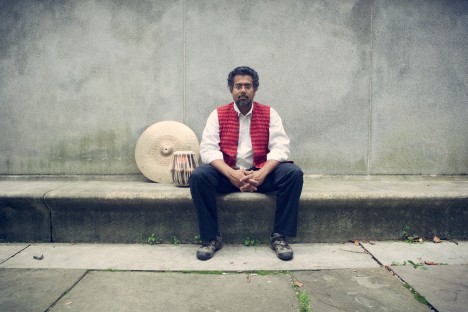
What’s your favorite time of day?
I love the late afternoon, after we’ve made it through a working day. The feeling of accomplishment and triumph is something so many people can connect with in everyday life, and it comes across powerfully in ragas that reflect “veer rasa,” which translates to “valor.”
What can listeners expect from your performance?
The musicians in my project humbly reflect a spectrum of influence from Indian classical to modern jazz as well many others traditions. We collaborate musically to have a rich shared improvisational dialogue which draws on these diverse influences. Our unifying efforts create music that acknowledges the roots we have come from while pushing the envelope and remaining fixed on the present and future.
What’s a fun fact about your instrument?
I have a unique style of playing my hybrid drumset/tabla setup, with a drum on each side of my drum throne, which allows me to use my feet while incorporating the sound of the tabla into the drum kit.
Camila Celin, sarod
Camila Celin is a guitarist and a devoted performer of the sarod. She has spent years in India and studied deeply with Krishna Bhatt and Tejendra Majumdar. At 6 a.m. she will prepare us for the sunrise.

What’s your favorite time of day?
I love midnight. The mood is tender and deep—a little dark and meditative, yet festive and going deeper into the darkness [until you] finally arrive, like an awakening of the soul into the light.
What can listeners expect from your performance?
They can expect an emotional and sincere rendition of the nostalgic and beautiful morning raga.
Arun Ramamurthy, violin
Arun Ramamurthy is a curator of the Ragas Live Festival and a co-founder of Brooklyn Raga Massive. He run will perform original works alongside Trina Basu, exploring traditional and contemporary sounds at sunset on Saturday, October 21.
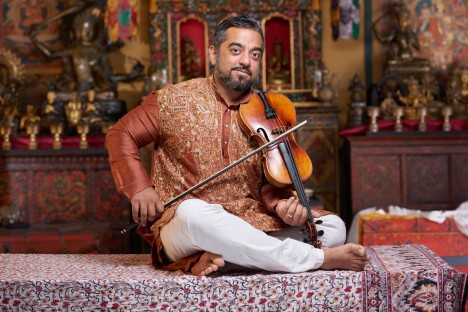
What’s your favorite time of day?
I love late morning the best. It’s the time of day when morning rituals are complete and the promise of the new day ahead awaits. It has a certain excitement, like the beginning of an improvised passage when you’re not sure exactly where it’s going to go.
What can listeners expect from your performance?
You will hear the original sound of two violinists from different lineages weaving in and out of each other, seamlessly traveling between Western harmony and Eastern expression. Expect lush chamber vibes, sounds that are raga-infused, gritty and graceful, folky and experimental. Performing as a quartet for Ragas Live, the group will move together through tight composition and free improvisation, creating moments of spontaneity and intimate connection.
Do you have a fun fact to share about yourself or your performance style?
For the first three or four years of my performing career, in my late teens, I insisted on drinking Snapple iced tea on stage. Couldn’t play without it!
Deepal Chodhari, santoor
Deepal Chodhari brings her magic touch on the santoor for the penultimate festival performance on Sunday morning.
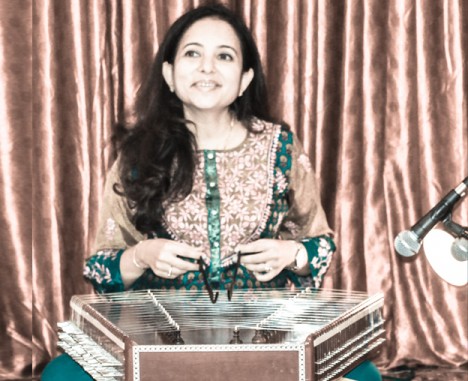
What’s your favorite time of day?
The best part of my day is when I practice the santoor beside my kids while they read every night. The musical synergy created is beyond the realm of my musical notes and ragas. It’s our family meditation together with the scintillating sounds of the santoor.
What can listeners expect from your performance?
I would love my listeners to immerse deep into meditation and thoughtfulness as I recite a beautiful morning raga followed by a soul-soothing folk tune.
Do you have a fun fact to share about yourself or your instrument?
My santoor has one hundred and two strings spanning across three octaves. I tune all the strings every day.
Swaminathan Selvaganesh, kanjira
The festival commences with one of the greatest living South Indian percussionists, V. Selvaganesh, who isknown for his work with John McLaughlin’s Shakti. He will be playing with the youngest generation of this important family in rhythm, Swaminathan Selvaganesh, who like his father, dazzles on the kanjira.
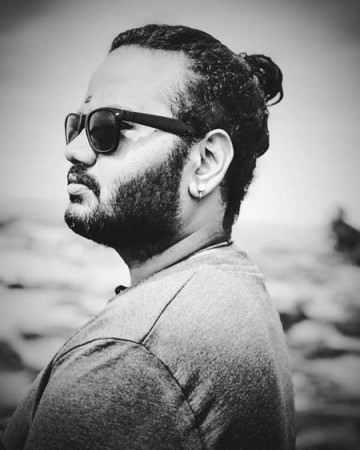
What’s your favorite time of day?
“Practice time” is my favorite time of the day.
What can listeners expect from your performance?
The audience can expect to join us for rhythmic entertainment with lots of surprise elements.
Do you have a fun fact to share about yourself or your instrument?
Fun fact! When I chose my instrument as a child, I thought, “Kanjira is a very easy instrument because it only requires one hand.” But later I understood that this makes it a little more difficult than other instruments because I have to do with a single hand what other drummers do with two!
Max ZT, hammered dulcimer
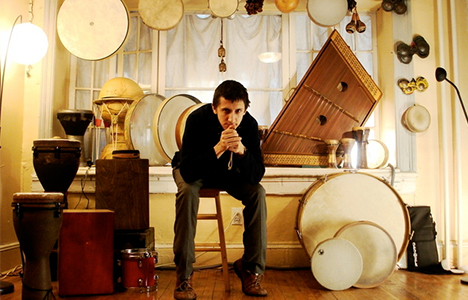
What’s your favorite time of day?
My favorite time of day is probably from the 1am-4am time period. I’m most productive during those hours, and find that all of the anxiety of the day melts away in those hours.
What can listeners expect from your performance?
For our concert at Ragas Live, listeners can expect an homage to our great gurus – Pandit Shivkumar Sharma, and Pandit Hariprasad Chaurasia. We will be working with the ragas performed by our gurus on Call of the Valley, the most iconic album of Indian classical music.
Fun fact:
I build my own instruments! I’ve been building my own instruments with master builder David Lindsey out of Oklahoma for the past ten years.
Mir Naqibul Islam, tabla
What’s your favorite time of day and why?
Midnight is my favorite time of day as it allows a quiet environment that helps me to concentrate on my music. I listen to my favorite tracks and try to do my reyaz (practice). The compositions that I try to innovate are mostly created during this particular hours.
What can listeners expect from your performance?
I try to play Pakhawaj bols (both in tabla and pakhwaj fingering). The audience may find the resulting sound a bit different than the contemporary players. You can also expect me to play some traditional tukda, paran, and gat while I finish a small solo during accompaniment.
Do you have a fun fact to share about your instrument?
The number of shirts I own is significantly less than the number of drums I have!
Roshni Samlal, tabla
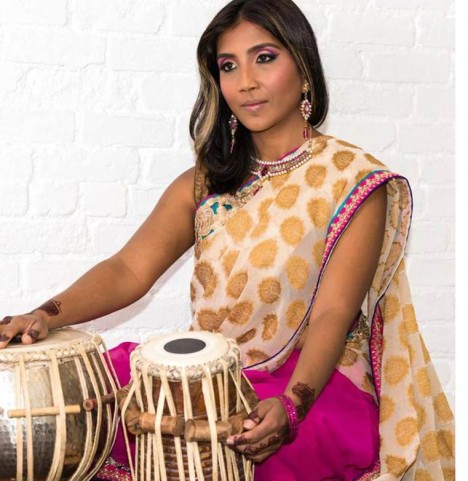
What’s your favorite time of day and why?
My favorite time of the day is between 2 and 4 A. M. I love the undisturbed, neutrality of quiet that exists without too much human activity. As a mom and a public school teacher, I can reclaim my personal riyaz and industry during these hours. I also enjoy a sunny high noon.
What can listeners expect from your performance?
Listeners can expect to hear rhythmically complex conversations between tabla and kora, percussive motifs that resolve in interesting patterns, referencing both Indian taal systems and motifs within the kora’s repertoire. We will incorporate some electronically processed tabla and kora and fixed media into our set. Kane also brings his brilliant oud repertoire into the mix and we’ve created new arrangements for some Indian classical and maqam based compositions.
Aakash Mittal, saxophone
What’s your favorite time of day and why?
My favorite time of day right now is the first few hours of morning after the sun has risen. I like to work creatively in the morning. It allows me to focus my energy on practicing and composing rather than being distracted or exhausted by the other events that come up during the day. It also allows me to prioritize my creative work. If I practice first then no matter what else comes up that day I have at least worked on music. I also love breakfast foods and the ritual of making chai or coffee in the morning.
What can listeners expect from your performance?
I will be performing my series of Nocturnes, which I wrote while living in Kolkata as a fellow of the American Institute of Indian Studies. Each piece uses a Hindustani evening or night raga as its foundation. Within the music, I have abstracted the raga into colorful dyads, angular rhythms, and high energy improvisation. In Kolkata the evening and night were often times of extreme activity and momentum rather than the serene calm often associated with the night. The music will evoke the sounds of the city and the improvisation of daily life while blurring the sounds of Hindustani raga sangeet.
Do you have a fun fact to share about your instrument?
When Adolphe Sax was inventing the saxophone the rival instrument makers at the time felt so threatened by his creation that they tried (and failed) to assassinate him.
Ehren Hanson, tabla
What’s your favorite time of day and why?
Early morning. I love the cool air, the light of the sky, and sounds of the melodies that come out of the early morning. The sentiments of ragas at that time are heavy and intense, and I love it.
What can listeners expect from your performance?
I am going to be listening carefully to the artists I’ll be accompanying and doing my best to highlight their rhythmic development with my improvised embellishments. It’s going to be fun!
Do you have a fun fact to share about your instrument?
The black spot on the Tabla skin is made from dough (for making bread) and iron fillings”¦ it’s what gives it a bell like tone.
Priya Darshini, vocals
Priya Darshini serenades in sounds beyond language, moving fluidly between Hebrew, Hindi and Aramaic backed by Oud, Violin, Hammered Dulcimer and Upright Bass. Come ready to be transported by ethereal music reminiscent of a loftier home.
What’s your favorite time of day?
I love dusk and dawn. There’s something profoundly moody and melancholic about it.
I especially love watching how the skies put on this stunning show of colour. It becomes a canvas of art at these times, like they’re communicating with the entire world.
What can listeners expect from your performance?
Prepare to go on a journey back in time. The Epichorus songs we will perform have this ancient ethereal quality to them.
Do you have a fun fact to share about yourself or your instrument?
I grew up in Bombay, India and started studying Carnatic Classical music as a three-year-old and then later Hindustani Classical music. As a young teenager, my friends would make fun of me for it”¦ It wasn’t considered the cool thing to do. So to cover up what I was doing, I took to playing with metal and rock bands and later jazz”¦ I loved it! But there was always something amiss. Eventually, I found my incredible Guruji, Sunil Borgaonkar, who helped me not only fall back deeply in love with our music but also to understand the philosophy of the music from deep within. I’m a student for life now and I’m deeply humbled and grateful for having the opportunity to study this music.
Eric Fraser, bansuri flute
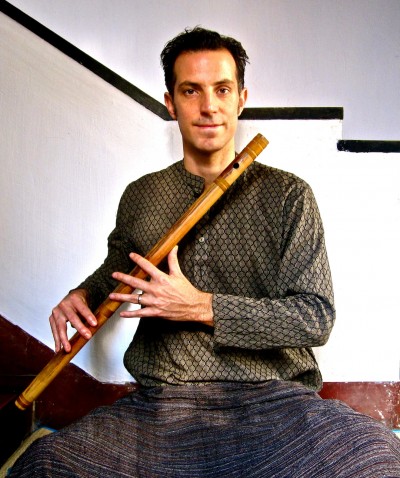
What’s your favorite time of day?
It’s a toss-up between deep night and early morning. For me, it’s about the stillness and the feeling that when so many people are sleeping, there is more space for consciousness to expand.
What can listeners expect from your performance?
A classical morning raga grounded in North Indian style, with a unique gayaki or vocal approach that comes from Kolkata, West Bengal. While living with my teacher, Pandit Gopal Roy, we used to practice every morning. The morning ragas are some of my favorites, and what I’ve practiced the most.
Do you have a fun fact to share about yourself or your instrument?
I’m also a multi-instrumentalist and Music Therapist, MA, MT-BC. I work with children with developmental disorders.
Aaron Shragge, trumpet
What’s your favorite time of day?
My favorite time of day is very early morning at about 5 or 6 AM. I find the stillness both inside me and around me comforting before the momentum of the day rushes in with the sunrise.
What can listeners expect from your performance?
I’ll be presenting two new compositions for Rez Abbasi and I based on Raag Lalit and Raag Bhairav. I play a custom trumpet that has both a slide as well as valves which allows me to play melodic phrases unique to Indian Classical music.
Mitali Bhawmik, vocals
What’s your favorite time of day?
Any time of a day is my favorite. I can get to sing Ragas appropriate for that time.
What can listeners expect from your performance?
I am planning to sing morning ragas and semi-classical pieces. I would like to present my rendition with different colors of fall filled with emotion, melody, pathos, and joy.
Samarth Nagarkar, Hindustani/North Indian classical vocals
What’s your favorite time of day and why?
My favorite time of day is whenever there’s music around me. In the context of this festival and the 24-hour raga time-cycle, I like the intensity of late night ragas and the bright passion of sunrise ragas.
What can listeners expect from your performance?
Singing a raga at its intended time of day/night makes it especially evocative. Night Ragas tend to be very intense in their appeal and often bear an introspective quality to them. My 10 P.M. performance will have ragas that depict these moods and be rendered in a traditional format, representing stylistic lineages of North Indian classical music. Do come and share the experience!

